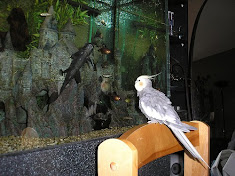 |
| Chameleon in Her Comfy Abode by jasmo |
1. Consider the proper placing of the light bulbs. Some owners just place the light bulbs anywhere they want to, or at any place at which the cage space can accommodate. Some owners on the other hand place lights in order to see clearly which directions their pet goes while inside the enclosure. However, lighting for chameleons serves a different purpose. When placed at the wrong positions, chameleons might get blinded by the light because the rays are just too much. Hence, when placing bulbs, particularly fluorescent ones, make sure that they allow only enough rays to get through the bottom of the cage; it is also recommended that they are placed just above the plants, so that there's still enough shade left for the chameleon to go to.
2. Use UVB bulbs at the lower parts of the cage. UVA and UVB bulbs have shorter wavelengths, and they become more useful during the darkness. Chameleons rely on UVB when hunting for food at night, however, since they are already in captivity, the ultraviolet rays serve to support the maintenance of their natural habitat, otherwise they will get homesick and depressed.
3. Offer sufficient heat inside the cage. Aside from light, chameleons also need humidity, and this can be generated not only by sufficient supply of water and mist, but also of heat. Thus, it is recommended to place a heater inside the cage to promote sufficient warmth for the chameleon to enjoy. This also encourages the development of better humidity, which is a crucial part of a chameleon's natural habitat.
4. Gauge the temperatures regularly. Things sometimes become too hot or too cold for a chameleon, thus you have to keep track of the changing temperatures inside the cage. If you don't know at which settings to adjust the heaters and misters, then you might as well make good use of a thermometer and hygrometer to measure the right amounts of heat and humidity in the enclosure. This way you will be able to set the surrounding tools properly and accordingly, thus keeping your chameleon happy.
Chameleons easily change their moods depending on their surrounding temperatures, thus it is important to keep their habitat cool and humid. Using the right tools will promote a more natural habitat, which chameleons love all throughout.
Author Resource: Written by Chris Smith
As a herp keeper, I have done tons of research on Chameleon Supplies to help keep your chameleons happy.



0 comments:
Post a Comment